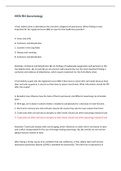Content
1. Lecture 1: HR Perspectives and Models .............................................................. 4
1.2 Content ..................................................................................................... 4
1.2.1 Universal perspective .......................................................................... 4
1.2.2 Perspectives on HRM: configurational, contingent, and contextual .......... 5
1.2.3 Best practice vs. best-fit perspective ..................................................... 6
1.2.4 The six-component model (Boselie, 2014) ............................................. 6
1.2.5 Contextually based HRM theory (Paauwe, 2004) .................................... 7
1.2.6 Institutional theory .............................................................................. 9
1.2.7 Isomorphism and Legitimacy ................................................................ 9
2. Lecture 2: Changing Organizations ................................................................... 11
2.1 Content ................................................................................................... 11
2.1.1 Self-employment ............................................................................... 11
2.1.2 Small businesses .............................................................................. 13
2.1.3 HR differentiation (Lepak & Shell, 2002)............................................... 13
2.1.4 Resource-based view (RBV) (Barney, 1991; Way, 2002) ......................... 13
2.1.5 Stakeholder vs. Shareholder Model (Beer et al., 2015; Bottenberg et al.,
2017) 15
2.1.6 Performance and Stakeholder Theory .................................................. 17
3. Lecture 3: Sustainability................................................................................... 19
3.1 Content ................................................................................................... 19
3.1.1 Sustainability: The Role of HRM .......................................................... 19
3.1.2 Sustainable and HRM ........................................................................ 19
3.1.3 Sustainable HRM: framework ............................................................. 22
3.1.4 Sustainable HRM: AMO Framework ..................................................... 22
3.1.5 Sustainable HRM: Paradox Theory....................................................... 23
3.1.6 Sustainable HRM: Roles taken by HR .................................................. 25
3.1.7 Green HRM ....................................................................................... 26
3.1.8 Common Good HRM .......................................................................... 26
4. Lecture 4: Sustainability and CSR ..................................................................... 27
4.1 Content ................................................................................................... 27
1
, 4.1.1 Corporate Social Responsibility (CSR) ................................................. 27
4.1.2 CSR: Embedded vs. Peripheral CSR .................................................... 27
4.1.3 CSR: Substantive or symbolic ............................................................. 28
4.1.4 CSR: HRM roles ................................................................................. 28
4.1.5 Organizational factors ........................................................................ 30
5. Lecture 5: Changing Labor Market .................................................................... 33
5.1 Content ................................................................................................... 33
1.1.1 Globalization ..................................................................................... 33
1.1.2 Comparative HR ................................................................................ 33
1.1.3 International HRM + approaches to HRM ............................................. 36
1.1.4 Cross-cultural HRM ........................................................................... 40
1.1.5 Managing the Global Workforce: Expatriation....................................... 41
1.1.6 Managing global virtual teams ............................................................ 42
6. Lecture 6: New Ways of Working (guest lecture) ................................................. 45
6.1 Content ................................................................................................... 45
6.1.1 New Ways of Working: the good news ................................................. 45
6.1.2 Working from home: the bad news ...................................................... 46
6.1.3 How can HRM help? ........................................................................... 47
7. Lecture 7: Social, Political, and Legal Environment ............................................ 48
7.1 Content ................................................................................................... 48
7.1.1 Examination of current development in the social, political, and legal
environment and their implications for HRM ...................................................... 48
7.1.2 Neoliberalism and individualization of the employment relationship ..... 49
7.1.3 Mainstream vs. critical HRM ............................................................... 51
7.1.4 Managing the social, political, and legal environment in the context of an
MNC. 51
8. Lecture 8: Cross- and International Labour Relations ......................................... 53
8.1 Content ................................................................................................... 53
9. Lecture 9: Algorithmic Management & Future HRM ............................................ 56
9.1 Content ................................................................................................... 56
9.1.1 Algorithmic Management ................................................................... 56
9.1.2 Algorithmic Management + HR practices ............................................. 57
2
, 9.1.3 Algorithmic Management in the Future ................................................ 58
10. Lecture 10: Exam Preparation ....................................................................... 59
11. Lecture 11: Well-Being ................................................................................. 59
11.1 Content ................................................................................................... 59
11.1.1 Well-being ......................................................................................... 59
11.1.2 HRM, Well-being, and Performance: Full mediation ............................. 59
11.1.3 HRM, Well-being, and Performance: Partial Mediation .......................... 60
11.1.4 HRM, Well-being, and Performance: Parallel outcomes model .............. 61
11.1.5 HR Practices and well-being ............................................................... 61
11.1.6 Model of caring HRM and employee engagement ................................. 62
11.1.7 PHRAME Model ................................................................................. 62
11.1.8 Well-being Paradox ............................................................................ 63
11.1.9 AMO practices and well-being ............................................................ 63
11.1.10 Job resource vs. challenge Demand HRM ......................................... 64
11.1.11 Meaningful work ............................................................................. 64
12. Lecture 12: Agile HR ..................................................................................... 66
12.1 Content ................................................................................................... 66
12.1.1 Agile HR ............................................................................................ 66
12.1.2 HR for Agile vs. Agile for HR ................................................................ 67
12.1.3 Theory of HR co-creation.................................................................... 68
3
,1. Lecture 1: HR Perspectives and Models
1.2 Content
✓ Universal perspective
✓ Perspectives on HRM
o Configurational perspective
o Contingent perspective
o Contextual perspective
✓ Best fit vs. best practice
✓ The six-component model
✓ Contextually based HRM theory
✓ Institutional theory
✓ Isomorphism and legitimacy
…………………………………………………………………………………………………………………………
HRM A distinctive approach to employment management that seeks to
obtain competitive advantage through the strategic deployment of a
highly committed and skilled workforce, using an array of cultural,
structural, and personnel techniques (Storey, 1995)
Pfeffer (1998): best practices
High-Performance Work System (HPWS)
HPWS refers to a set of HR practices designed to improve employee performance and,
consequently, the overall performance of the organization.
Employment security/ stability
Selective hiring of new personnel
Self-managed teams/ decentralization
High compensation contingent on organizational performance
Extensive training
Extensive sharing of information
Job design
Training
1.2.1 Universal perspective
❖ Universal perspective/ best practice models
It suggests that certain HR practices or strategies universally lead to better
organizational performance, regardless of the organization's specific context or
conditions.
Huselid (1995) states that this perspective delivers enhanced organizational
performance.
Empirical support for the universal perspective (Liao et al., 2009):
4
, 1.2.2 Perspectives on HRM: configurational, contingent, and contextual
❖ Configurational perspective:
An approach that focuses on the alignment and interaction of various HR practices to
form a coherent and internally consistent system. It suggests that it is not individual HR
practices alone that lead to superior performance, but rather the way these practices
are combined and configured to fit the overall strategy and context of the organization;
internal dynamics of the HRM system
❖ Contingent perspective:
A perspective that suggests that the effectiveness of HR practices depends on their
alignment or ‘fit’ with various internal and external factors, such as the organization’s
strategy, structure, culture, and external environment. It argues that there is no single
best way to manage people. Instead, HR practice should be tailored to the specific
circumstances of the organization.
❖ Contextual perspective:
This perspective focuses on understanding how various external and internal contextual
factors influence HR practices and their effectiveness. It takes a broader view than
previous perspectives. It considers the overall environment and context in which an
organization operates, including cultural, economic, legal, and social influences.
External influences (contextual perspective):
5










